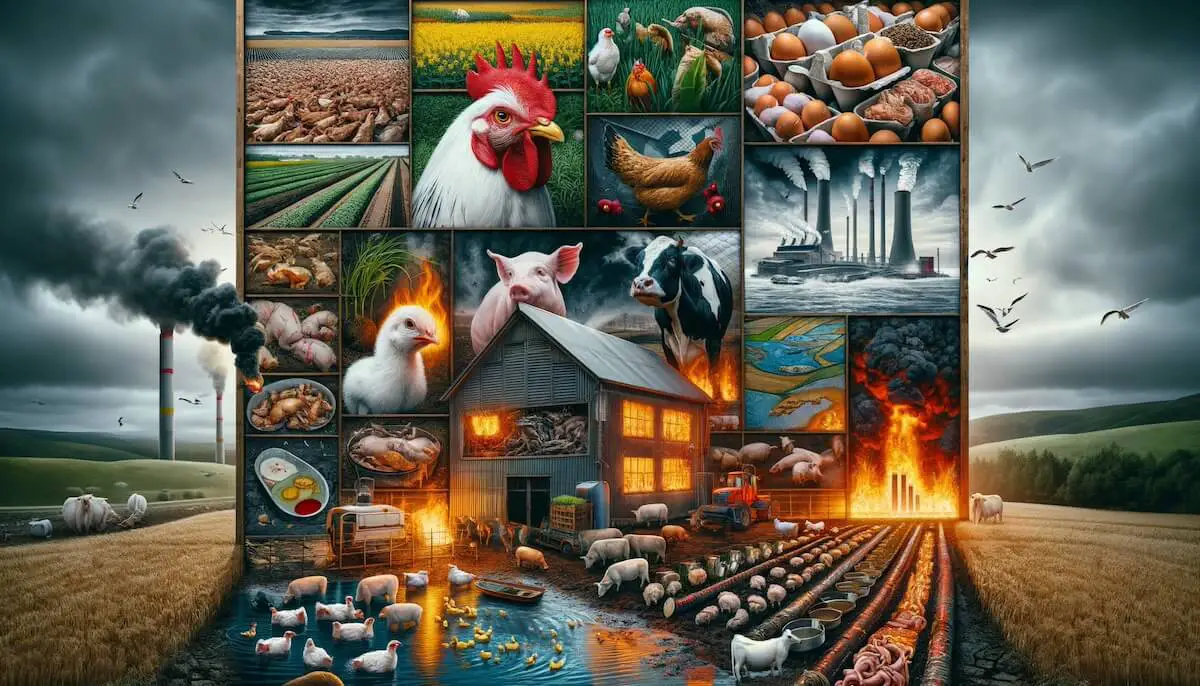The way we do animal agriculture has to change. The global consumption of animal products is staggering, with billions of animals bred, raised, and slaughtered annually to satisfy human dietary preferences.
Recent research sheds light on a startling revelation: an estimated 18 billion animal lives were lost due to inefficiencies and waste within the meat production and consumption cycle in 2019 alone.
These figures underscore the magnitude of the impact of animal agriculture on both sentient beings and the environment.
As the demand for meat surges worldwide, so does the scale of animal suffering. From factory farms to slaughterhouses, the industry not only perpetuates cruelty but also exacts a heavy toll on the planet.
The environmental repercussions of animal agriculture are undeniable, with livestock farming being a significant contributor to greenhouse gas emissions, land degradation, and water pollution.
Most crucially, the ethical implications of mass animal farming cannot be overlooked. Chickens, pigs, cows, and other sentient beings endure lives of confinement, stress, and deprivation before meeting their fate on the dinner table.
As awareness grows regarding the moral dilemmas posed by the meat industry, more individuals are turning towards veganism as a compassionate and sustainable alternative.
This article delves into the global truth about animal farming, highlighting the staggering number of lives lost and the environmental impact of meat production.
Through a comprehensive examination of data and trends, it underscores the urgent need to rethink our food systems and embrace a vegan lifestyle for the well-being of animals, the planet, and future generations.
The Global Truth about Animal Agriculture
According to Humane Society International, more than 92 billion land animals are bred and subsequently, slaughtered for food all across the world on an annual level.
Within the industry, there is an estimated one billion people who are involved in the rearing, processing, or distribution of livestock, and the ‘energy impact’ of the whole animal-farming industry is considerable.
The processes include the transportation of animals from the farm to the slaughterhouse, to the shops and eventually, to the kitchen table.
A research paper entitled Animal lives embodied in food production and waste revealed that one third of the animals that end up in the slaughterhouse (18 billion) are killed for nothing.
Many of these animals could be saved if certain efficiencies in the farming and food chain supply were mainstreamed. This is an overwhelming statistic about the needless suffering and death of billions of animals.
57 per cent of these animal life losses occurred in the top 10 countries with China at the top, followed by the US, Brazil, Indonesia, the Russian Federation, India, Mexico, South Africa, Egypt and the UK at the bottom.

The data utilizes moral values. According to this research paper, of the 80 million morally-adjusted deaths across species – about 70-79 per cent of the animals slaughtered were chickens assigning what is termed a ‘low morale-value’.
This means that although it is the species that suffers the most loss of life, other species such as pigs have higher cognitive abilities and so, experience more suffering as a result.
Environmental Impact of Animal Agriculture
Animal-based foods impact the environment more heavily than plant-based foods would.
Meat has the highest levels of greenhouse gas emissions per kilogram and equates to costly consumer expenditures.
The production of meat costs is expected to continue to rise in the coming years.
Livestock and poultry farming has a serious environmental impact on the land – the soil, water and air and is deemed a main driver for the loss of biodiversity so going vegan to help the environment would be highly beneficial.
Information by the Humane Society International reveals that more than 16.5 per cent of greenhouse gas emissions comes from human-caused animal agriculture and estimates the industry will be responsible for more than 50 per cent of the world’s emissions through potent greenhouse gases – methane and nitrous oxide and the displacement of biomass carbon on the land utilised for livestock.
Approximately 11 per cent of animal agriculture contributes to greenhouse gas emissions.
This includes carbon dioxide, and methane. Soil degradation, erosion, waterlogging or the compaction or crusting of soils is often caused as a result of animal agriculture.
Flatulence or burping cows impacts air quality with the release of methane which is also caused by nitrogen-based fertilizers often added to crops and by the breakdown of animal waste.
Run-off from farmland leads to waterway contamination through phosphate, nitrate, viruses and antibiotics and an excessive richness of nutrients and algal blooms which is devastating for wildlife.
A research study in 2022 by Michael B. Elsen and Patrick O. Brown considered that rapid global phaseout of animal agriculture had the potential to stabalize greenhouse gas emissions for a 30 year period. 68 per cent of CO2 emissions would be offset.
Antibiotic overuse for animals also poses a serious risk.
Deaths in Animal Agriculture
Animals are sentient and more intelligent than many people consider so atrocities such as keeping chicken in cages and the transportation of sheep for up to 24 hours without any food or drink are just two examples of practices that need to be stopped.
Animals are capable of complex emotions and are worthy or more consideration than just a 10 minute meal to us.
For example, cows can experience complex emotions including grief, fear and loneliness.
Pigs are often widely misunderstood with highly sociable behaviour but are forced to endure cramped and confined environments within factory farms. Farmers involved with pig intelligence studies have confirmed that pigs feel fear, stress, and joy.
Sheep also possess a capacity for learning, and impressive cognitive abilities.
There are countless other examples of how animals are smarter than we ever thought before but this doesn’t really matter. All we need to know is if they can suffer. And they clearly can.
The reality is stark as hundreds of millions of animals are killed for consumption each day.
However, if the vegan movement continues to grow, it could reduce or even, eradicate the need for the livestock industry in the future.
Land Animal Deaths – Canada
In 2022, in Canada, 841 million land animals were killed for food – an increase from 825 million in 2021 and 812 million in 2020.
Consumers have turned more to chicken and begun to shift away from the consumption of cows and pigs.
Note: These statistics do not include the millions of male chicks killed immediately following birth.
According to Animal Justice at least 12,800,000 chicks were ground up alive with more than five million chicks killed in meat chicken hatcheries.
Turkey chicks also suffered with more than one million birds killed.
The Food and Agriculture Organization (FAO) of the United Nations (UN) specifies that chickens are the most slaughtered land animal, followed by pigs, sheep, and cows.
According to Animal Clock Canada data, there is hope for the future of veganism with plant-based options increasing in grocery stores and vegan restaurants opening in cities and towns.
Land Animal Deaths – US
In 2019, more than 160 million, cattle, calves, hogs, sheep, and lambs were killed for food according to a report from the United States Department of Agriculture (USDA) and 9 billion chickens, turkeys and ducks.
An estimation by the USDA reveals 99 per cent of livestock were factory farmed. This equates to 10 billion animals.
Data on the Animal Kill Clock reveals the following deaths in 2024
- Chickens – 8,127,632,113
- Turkeys – 214,508,816
- Pigs – 124,061,094
- Cattle – 36,163,973
Land Animal Deaths in first 3 months of 2024 – UK
- Chickens – 1,000,000,000
- Turkeys – 15,000,000
- Sheep – 14,000,000
- Cattle – 2,800,000
- Pigs -1,000,000
It is worth noting that slaughter rates may increase at specific times of the year. Consider turkeys and thanksgiving in the US or in the UK at Christmas.
It is also important to consider that the number of animals which are slaughtered for meat consumption does not reflect how many animals die per individual.
Sobering Reality of the Way we use Animals
In conclusion, the revelations regarding the immense toll of animal agriculture on both sentient beings and the planet necessitate urgent action.
The staggering loss of billions of animal lives annually, coupled with the environmental degradation caused by meat production, underscores the need for a paradigm shift in our food systems.
As awareness grows and more individuals embrace veganism as a compassionate and sustainable alternative, there is hope for a future where animal suffering is minimized, and the planet’s resources are conserved.
It is imperative that we continue to advocate for ethical and environmentally friendly food practices, recognizing that every choice we make has a profound impact on the world around us.


Leave a Reply